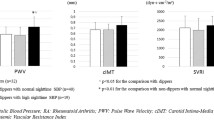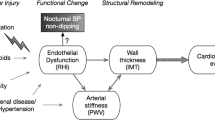Summary
Background
Psoriasis vulgaris is one of the most prevalent chronic, inflammatory skin disorders. Patients with psoriasis carry an excess risk of hypertension and adverse cardiovascular (CV) events. Blood pressure (BP) has a circadian rhythm characterised with lower values at night. A blunted nocturnal BP decline defined as non-dipping accelerates the development of hypertension and CV diseases. The aim of this study is to evaluate circadian variation of blood pressure in normotensive middle-aged patients with psoriasis vulgaris.
Methods
Seventy adult patients with psoriasis vulgaris (group 1) and 70 age and sex-matched healthy individuals (group 2) were included in the study. Ambulatory BP monitoring was performed in all participants over a 24-h period. Non-dippers are defined as those who show a reduction in BP of less than 10 % between the average day and night systolic BP.
Results
Although mean 24-h BPs were similar in both groups, night-time BPs were significantly higher in psoriatic patients (115.1 ± 7.7 vs. 109.9 ± 6.0 mmHg and 72.1 ± 7.0 vs. 67.6 ± 5.5 mmHg, respectively; p < 0.05). The non-dipping pattern of BP changes was significantly more common in patients with psoriasis vulgaris compared with the control group (65.9 vs. 34.1 %, p < 0.01). Psoriasis severity and BMI are independent predictors of impaired nocturnal BP regulation.
Conclusions
Patients with psoriasis vulgaris had increased nocturnal BP and heart rate. This is the first study to demonstrate a blunted nocturnal BP decrease in normotensive patients with psoriasis.
Zusammenfassung
Grundlagen
Psoriasis vulgaris ist eine der häufigsten chronischen entzündlichen Hauterkrankungen. Patienten mit Psoriasis haben ein erhöhtes Risiko einer Hypertonie und kardiovaskulärer Ereignisse. Der Blutdruck (RR) hat normaler Weise einen zirkadianen Rhythmus, charakterisiert durch niedrigere Werte während der Nacht. Ein Fehlen dieses Abfalls des RRs („Non-Dipping“) beschleunigt die Entwicklung einer Hypertonie und kardiovaskulärer Erkrankungen. Ziel dieser Studie ist es, den zirkadianen Rhythmus des RRs bei normotensiven Patienten mittleren Alters mit Psoriasis vulgaris zu evaluieren.
Methodik
Siebzig erwachsene Patienten mit Psoriasis vulgaris (= Gruppe 1) und 70 alters-und geschlechts-gematchte gesunde Personen (= Gruppe 2) wurden in die Studie aufgenommen. Bei allen Teilnehmern an der Studie wurde ein ambulantes 24-h RR Monitoring durchgeführt. „Non-Dippers“ wurden definiert als jene, die weniger als 10 % Abfall des systolischen RRs nachts – im Vergleich zum mittleren systolischen RR während des Tages aufwiesen.
Ergebnisse
Obwohl die mittleren 24 h RR Werte in beiden Gruppen ähnlich waren, waren die nächtlichen RR Werte bei den Psoriasis Patienten signifikant höher (115,1 ± 7,7 vs. 109,9 ± 6,0 mmHg und 72,1 ± 7,0 vs. 67,6 ± 5,5 mmHg, respektive; p < 0,05). Das „Non-Dipping“ Muster der RR Veränderungen war bei Psoriasis vulgaris signifikant häufiger als in der Kontrollgruppe (65,9 vs. 34,1 %, p < 0,01). Der Schweregrad der Psoriasis und der BMI waren unabhängige Prädiktoren einer gestörten nächtlichen RR Regulation.
Schlussfolgerungen
Patienten mit Psoriasis vulgaris hatten erhöhte nächtliche RR Werte und Herzfrequenz. Dies ist die 1. Studie, die ein Fehlen des nächtlichen RR Abfalls bei normotensiven Psoriasis Patienten zeigt.


Similar content being viewed by others
References
Soylu A, Yazici M, Duzenli MA, Tokac M, Ozdemir K, Gok H. Relation between abnormalities in circadian blood pressure rhythm and target organ damage in normotensives. Circ J. 2009;73(5):899–904.
Li L, Soonthornpun S, Chongsuvivatwong V. Association between circadian rhythm of blood pressure and glucose tolerance status in normotensive, non-diabetic subjects. Diabetes Res Clin Pract. 2008;82(3):359–63.
Sayk F, Becker C, Teckentrup C, Fehm HL, Struck J, Wellhoener JP, et al. To dip or not to dip: on the physiology of blood pressure decrease during nocturnal sleep in healthy humans. Hypertension. 2007;49(5):1070–6.
Cuspidi C, Meani S, Valerio C, Negri F, Sala C, Maisaidi M, et al. Body mass index, nocturnal fall in blood pressure and organ damage in untreated essential hypertensive patients. Blood Press Monit. 2008;13(6):318–24.
Kawano Y, Horio T, Matayoshi T, Kamide K. Masked hypertension: subtypes and target organ damage. Clin Exp Hypertens. 2008;30(3):289–96.
Viera AJ, Zhu S, Hinderliter AL, Shimbo D, Person SD, Jacobs DR Jr. Diurnal blood pressure pattern and development of prehypertension or hypertension in young adults: the CARDIA study. J Am Soc Hypertens. 2011;5(1):48–55.
Hermida RC, Chayán L, Ayala DE, Mojón A, Domínguez MJ, Fontao MJ, et al. Association of metabolic syndrome and blood pressure nondipping profile in untreated hypertension. Am J Hypertens. 2009;22(3):307–13.
Hansen TW, Jeppesen J, Rasmussen S, Ibsen H, Torp-Pedersen C. Ambulatory blood pressure monitoring and risk of cardiovascular disease: a population based study. Am J Hypertens. 2006;19(3):243–50.
Ohkubo T, Imai Y, Tsuji I, Nagai K, Watanabe N, Minami N, et al. Relation between nocturnal decline in blood pressure and mortality. The Ohasama Study. Am J Hypertens. 1997;10(11):1201–7.
Schön MP, Boehncke WH. Psoriasis. N Engl J Med. 2005;352(18):1899–912.
Rosa DJ, Machado RF, Matias FA, Cedrim SD, Noronha FL, Gaburri D, et al. Influence of severity of the cutaneous manifestations and age on the prevalence of several cardiovascular risk factors in patients with psoriasis. J Eur Acad Dermatol Venereol. 2012;26(3):348–53.
Markuszeski L, Bissinger A, Janusz I, Narbutt J, Jedrzejowska AS, Zalewska A. Heart rate and arrhythmia in patients with psoriasis vulgaris. Arch Med Res. 2007;38(1):64–9.
Ahlehoff O, Gislason GH, Jørgensen CH, Lindhardsen J, Charlot M, Olesen JB, et al. Psoriasis and risk of atrial fibrillation and ischaemic stroke: a Danish Nationwide Cohort Study. Eur Heart J. 2012;33(16):2054–64.
Sommer DM, Jenisch S, Suchan M, Christophers E, Weichenthal M. Increased prevalence of the metabolic syndrome in patients with moderate to severe psoriasis. Arch Dermatol Res. 2006;298(7):321–8.
Zindancı I, Albayrak O, Kavala M, Kocaturk E, Can B, Sudogan S, et al. Prevalence of metabolic syndrome in patients with psoriasis. ScientificWorldJournal. 2012;2012:312463.
Louden BA, Pearce DJ, Lang W, Feldman SR. A Simplified Psoriasis Area Severity Index (SPASI) for rating psoriasis severity in clinic patients. Dermatol Online J. 2004;10(2):7.
Amornpinyokeit N, Asawanonda P. 8-Methoxypsoralen cream plus targeted narrowband ultraviolet B for psoriasis. Photodermatol Photoimmunol Photomed. 2006;22:285–9.
Rich P, Scher RK. Nail Psoriasis Severity Index: a useful tool for evaluation of nail psoriasis. J Am Acad Dermatol. 2003;49:206–12.
Pickering TG, Hall JE, Appel LJ, Falkner BE, Graves J, Hill MN, et al. Recommendations for blood pressure measurement in humans and experimental animals: part 1: blood pressure measurement in humans: a statement for professionals from the subcommittee of professional and public education of the American Heart Association Council on High Blood Pressure Research. Circulation. 2005;111:697–716.
Madin K, Iqbal P. Twenty four hour ambulatory blood pressure monitoring: a new tool for determining cardiovascular prognosis. Postgrad Med J. 2006;82(971):548–51.
Ezzati M, Lopez AD, Rodgers A, Vander Hoorn S, Murray CJ, Comparative Risk Assessment Collaborating Group. Selected major risk factors and global and regional burden of disease. Lancet. 2002;360:1347–60.
Mancia G, De Backer G, Dominiczak A, Cifkova R, Fagard R, Germano G, et al. 2007 Guidelines for the management of arterial hypertension: the task force for the management of arterial hypertension of the European Society of Hypertension (ESH) and of the European Society of Cardiology (ESC). Eur Heart J. 2007;28(12):1462–536.
Mittal BV, Singh AK. Hypertension in the developing world: challenges and opportunities. Am J Kidney Dis. 2010;55(3):590–8.
Pierdomenico SD, Cuccurullo F. Ambulatory blood pressure monitoring in type 2 diabetes and metabolic syndrome: a review. Blood Press Monit. 2010;15(1):1–7.
O’Brien E. Twenty-four-hour ambulatory blood pressure measurement in clinical practice and research: a critical review of a technique in need of implementation. J Intern Med. 2011;269(5):478–95.
Liu T, Li G. Psoriasis, inflammation, and atrial fibrillation. Am J Cardiol. 2008;102(5):647.
Flammer AJ, Ruschitzka F. Psoriasis and atherosclerosis: two plaques, one syndrome? Eur Heart J. 2012;33(16):1989–91.
Rico T, Marchione R, Kirsner RS. Vascular disease in psoriasis. J Invest Dermatol. 2009;129(10):2327.
Daudén E, Castañeda S, Suárez C, García-Campayo J, Blasco AJ, Aguilar MD, et al. Integrated approach to comorbidity in patients with psoriasis. Actas Dermosifiliogr. 2012;103(Suppl 1):1–64.
Armstrong AW, Lin SW, Chambers CJ, Sockolov ME, Chin DL. Psoriasis and hypertension severity: results from a case-control study. PLoS One. 2011;6(3):e18227.
Halıgür BD, Cicek D, Bulut S, Berilgen MS. The investigation of autonomic functions in patients with psoriasis. Int J Dermatol. 2012;51(5):557–63. doi:10.1111/j.1365-4632.2011.05111.x.
Ena P, Madeddu P, Glorioso N, Cerimele D, Rappelli A. High prevalence of cardiovascular diseases and enhanced activity of the renin-angiotensin system in psoriatic patients. Acta Cardiol. 1985;40(2):199–205.
Boehncke WH, Boehncke S. Cardiovascular morbidity in psoriasis: epidemiology, pathomechanisms, and clinical consequences. G Ital Dermatol Venereol. 2008;143(5):307–13.
Enany B, El Zohiery AK, Elhilaly R, Badr T. Carotid intima-media thickness and serum leptin in psoriasis. Herz. 2012;37(5)527–33.
Gisondi P, Fantin F, Del Giglio M, Valbusa F, Marino F, Zamboni M, Girolomoni G. Chronic plaque psoriasis is associated with increased arterial stiffness. Dermatology. 2009;218(2):110–3.
Birkenhäger AM, Van Den Meiracker AH. Causes and consequences of a non-dipping blood pressure profile. Neth J Med. 2007;65(4):127–31.
Pickering TG, Kario K. Nocturnal non-dipping: what does it augur? Curr Opin Nephrol Hypertens. 2001;10(5):611–6.
Minamisawa K, Tochikubo O, Ishii M. Systemic hemodynamics during sleep in young or middle-aged and elderly patients with essential hypertension. Hypertension. 1994;23(2):167–73.
Ulusoy RE, Karabudak O, Yokusoglu M, Kilicaslan F, Kirilmaz A, Cebeci BS. Noninvasive assessment of impaired endothelial function in psoriasis. Rheumatol Int. 2010;30(4):479–83.
Hermida RC, Chayán L, Ayala DE, Mojón A, Domínguez MJ, Fontao MJ, et al. Association of metabolic syndrome and blood pressure nondipping profile in untreated hypertension. Am J Hypertens. 2009;22(3):307–13.
Schmitt J, Wozel G. The psoriasis area and severity index is the adequate criterion to define severity in chronic plaque-type psoriasis. Dermatology. 2005;210(3):194–9.
Ryan MJ. The pathophysiology of hypertension in systemic lupus erythematosus. Am J Physiol Regul Integr Comp Physiol. 2009;296(4):R1258–67.
Bevelacqua V, Libra M, Mazzarino MC, Gangemi P, Nicotra G, Curatolo S, et al. Long pentraxin 3: a marker of inflammation in untreated psoriatic patients. Int J Mol Med. 2006;18(3):415–23.
Rihácek I, Frána P, Soucek M, Plachý M, Kianicka B. The diurnal variability of blood pressure in patients with hypertension and rheumatoid arthritis. Vnitr Lek. 2009;55(2):111–6.
Conflict of interest
The authors declare that there is no conflict of interest.
Author information
Authors and Affiliations
Corresponding author
Rights and permissions
About this article
Cite this article
Bacaksiz, A., Akif Vatankulu, M., Sonmez, O. et al. Non-dipping nocturnal blood pressure in psoriasis vulgaris. Wien Klin Wochenschr 124, 822–829 (2012). https://doi.org/10.1007/s00508-012-0294-y
Received:
Accepted:
Published:
Issue Date:
DOI: https://doi.org/10.1007/s00508-012-0294-y
Schlüsselwörter
- Psoriasis
- Ambulantes 24-h blutdruck monitoring
- Fehlendes dipping des nächtlichen blutdruck
- Kardiovaskulären risikos




